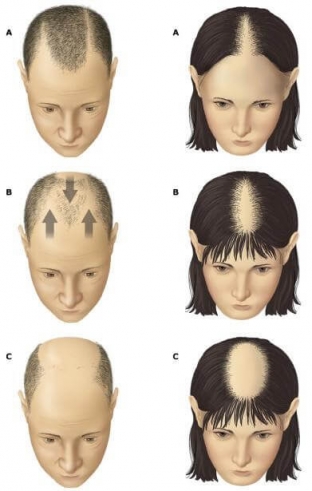Alopecia is called abnormal hair loss, accompanied by a violation of their growth. This problem occurs in men, women and even children. There are various types of baldness that can affect not only the scalp, but also other parts of the body. Alopecia – a non-contagious and non-life-threatening disease, the main nuisance of which for the patient lies in the psychological discomfort that occurs due to the lack of a normal amount of hair. With regard to alopecia, the treatments available today can stop the loss and restore hair. These methods will be discussed by estet-portal.com.
The choice of treatments for alopecia depends on the cause of the disease

There are many types of alopecia, which manifest themselves in different ways and are the result of various factors – from genetic predisposition to physical trauma and psychological stress. Accordingly, in order to select effective methods for the treatment of alopecia, it is first necessary to establish the type and cause of baldness.
Alopecia occurs in the form of hair loss:
- total (no hair at all);
- diffuse (hair thins evenly);
- focal (hair falls out in separate limited areas).
The causes of the disease include:
- pregnancy;
- long-term medication use;
- endocrine disorders;
- fungal lesions;
- radiotherapy;
- exposure to toxins;
- elevated levels of androgenic hormones;
- infectious diseases;
- disturbances in the work of the ovaries;
- impaired pituitary function;
- oncological diseases;
- physical injury;
- seborrhea;
- stress;
- autoimmune diseases;
- metabolic disorders;
- diseases of the digestive system;
- diseases of the nervous system.
If you notice that during shampooing and / or combing you lose more hair than usual, estet-portal.com recommends contacting a trichologist to determine the type and cause of hair loss, as well as to choose an effective treatment plan.
Alopecia caused by hormonal causes is treated by a trichologist, endocrinologist and gynecologist (for female pattern baldness).
Which alopecia treatments are used for hair restoration?
An integrated approach to the treatment of alopecia is primarily aimed at neutralizing the cause of hair loss, and only after that – to restore their growth. Accordingly, depending on the trigger of the disease, the physician may:
- prescribe a set of measures aimed at treating the disease causing baldness,
- direct efforts to neutralize negative external factors;
- give advice on lifestyle changes;
- correct the patient's diet, etc.
Common treatments for alopecia are:
- food;
- minoxidil;
- massages;
- hair transplantation.
Nutrition as one of the most important treatments for alopecia
Alopecia is often observed when the quality of the patient's nutrition deteriorates. For example, increased hair loss can be the result of debilitating diets, during which the body directs nutrients to perform vital functions, and there are few reserves for less important things (such as nourishing hair). Often, hair loss is the result of a lack of protein in the diet, so nutrition as an auxiliary treatment for alopecia is of great importance.
A diet high in protein and iron (fish, chicken, leafy greens) will help stimulate hair growth and keep the body in shape without compromising health.
Effective treatment for alopecia with minoxidil
Minoxidil is an effective treatment for alopecia. This vasodilator has been approved by the FDA and the European Medicines Agency for use in androgenetic alopecia. Minoxidil is not used for baldness of the front of the scalp or for bald patches starting from the hairline in men.
2% or 5% minoxidil for the treatment of alopecia, if this method is appropriate, the doctor prescribes. It is worth remembering that the effect is observed only 10-12 months after the start of the drug. Also, minoxidil is characterized by side effects and contraindications, for example, disorders in the cardiovascular system, pregnancy, and after stopping the use of the drug, the hair will fall out again.
Home Treatment for Alopecia: Massages with Natural Oils
This method of hair regrowth has its advantages: naturalness, availability and the ability to use at home. However, you should not have high hopes if the massages – the only alopecia treatment you are going to use.
Self-massage can be a great home-based addition to your doctor's prescribed treatment plan, but remember that it won't fix the cause of your hair loss.
Try regular scalp massage with castor oil or coconut oil to improve blood circulation and ensure the flow of nutrients to the hair follicles.
Self-massage can be a great home-based addition to your doctor's prescribed treatment plan, but remember that it won't fix the cause of your hair loss.
Hair Transplant – the most effective treatment for alopecia
This method of treatment of alopecia, or rather, the restoration of lost hair, is the most radical, but at the same time the most effective to date. Since the advent of hair transplantation in the 1950s, this technique has been greatly improved, so that transplantation can be carried out with minimal trauma and virtually no scars.
The procedure involves moving hair follicles from the hair growth area (donor area) to the bald area. There are different hair transplant techniques, you can get detailed information about them during a consultation with a specialist.
Read also: New alopecia treatment protocol: mesotherapy + botulinum toxin
Methods for the treatment of alopecia are constantly being improved, new studies are being conducted, and effective protocols are being drawn up. Therefore, if you notice that the hair begins to fall out in larger quantities than usual, contact a trichologist – timely identification of the root cause will minimize hair loss, and therefore reduce the cost and effort for their further restoration.






Add a comment